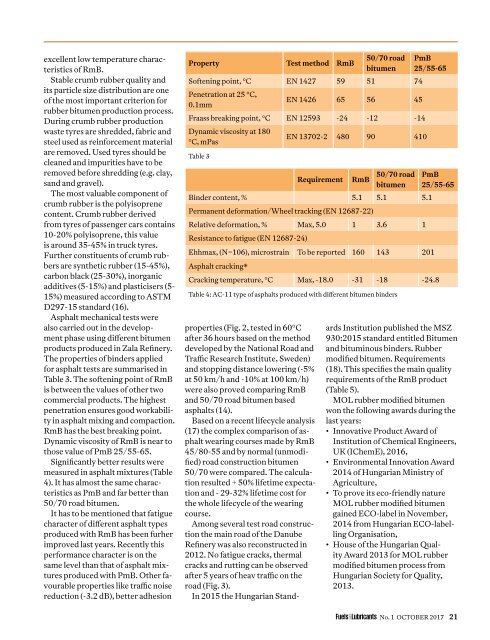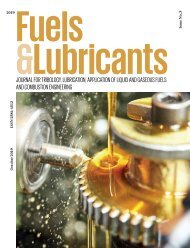Fuels & Lubricants Magazine
Issue 1, October 2017
Issue 1, October 2017
You also want an ePaper? Increase the reach of your titles
YUMPU automatically turns print PDFs into web optimized ePapers that Google loves.
excellent low temperature characteristics<br />
of RmB.<br />
Stable crumb rubber quality and<br />
its particle size distribution are one<br />
of the most important criterion for<br />
rubber bitumen production process.<br />
During crumb rubber production<br />
waste tyres are shredded, fabric and<br />
steel used as reinforcement material<br />
are removed. Used tyres should be<br />
cleaned and impurities have to be<br />
removed before shredding (e.g. clay,<br />
sand and gravel).<br />
The most valuable component of<br />
crumb rubber is the polyisoprene<br />
content. Crumb rubber derived<br />
from tyres of passenger cars contains<br />
10-20% polyisoprene, this value<br />
is around 35-45% in truck tyres.<br />
Further constituents of crumb rubbers<br />
are synthetic rubber (15-45%),<br />
carbon black (25-30%), inorganic<br />
additives (5-15%) and plasticisers (5-<br />
15%) measured according to ASTM<br />
D297-15 standard (16).<br />
Asphalt mechanical tests were<br />
also carried out in the development<br />
phase using different bitumen<br />
products produced in Zala Refinery.<br />
The properties of binders applied<br />
for asphalt tests are summarised in<br />
Table 3. The softening point of RmB<br />
is between the values of other two<br />
commercial products. The highest<br />
penetration ensures good workability<br />
in asphalt mixing and compaction.<br />
RmB has the best breaking point.<br />
Dynamic viscosity of RmB is near to<br />
those value of PmB 25/55-65.<br />
Significantly better results were<br />
measured in asphalt mixtures (Table<br />
4). It has almost the same characteristics<br />
as PmB and far better than<br />
50/70 road bitumen.<br />
It has to be mentioned that fatigue<br />
character of different asphalt types<br />
produced with RmB has been furher<br />
improved last years. Recently this<br />
performance character is on the<br />
same level than that of asphalt mixtures<br />
produced with PmB. Other favourable<br />
properties like traffic noise<br />
reduction (-3.2 dB), better adhesion<br />
Property Test method RmB<br />
50/70 road<br />
bitumen<br />
Softening point, °C EN 1427 59 51 74<br />
Penetration at 25 °C,<br />
0.1mm<br />
EN 1426 65 56 45<br />
Fraass breaking point, °C EN 12593 -24 -12 -14<br />
Dynamic viscosity at 180<br />
°C, mPas<br />
Table 3<br />
EN 13702-2 480 90 410<br />
Requirement RmB<br />
50/70 road<br />
bitumen<br />
PmB<br />
25/55-65<br />
Binder content, % 5.1 5.1 5.1<br />
Permanent deformation/Wheel tracking (EN 12687-22)<br />
Relative deformation, % Max, 5.0 1 3.6 1<br />
Resistance to fatigue (EN 12687-24)<br />
Ehhmax, (N=106), microstrain To be reported 160 143 201<br />
PmB<br />
25/55-65<br />
Asphalt cracking*<br />
Cracking temperature, °C Max, -18.0 -31 -18 -24.8<br />
Table 4: AC-11 type of asphalts produced with different bitumen binders<br />
properties (Fig. 2, tested in 60°C<br />
after 36 hours based on the method<br />
developed by the National Road and<br />
Traffic Research Institute, Sweden)<br />
and stopping distance lowering (-5%<br />
at 50 km/h and -10% at 100 km/h)<br />
were also proved comparing RmB<br />
and 50/70 road bitumen based<br />
asphalts (14).<br />
Based on a recent lifecycle analysis<br />
(17) the complex comparison of asphalt<br />
wearing courses made by RmB<br />
45/80-55 and by normal (unmodified)<br />
road construction bitumen<br />
50/70 were compared. The calculation<br />
resulted + 50% lifetime expectation<br />
and - 29-32% lifetime cost for<br />
the whole lifecycle of the wearing<br />
course.<br />
Among several test road construction<br />
the main road of the Danube<br />
Refinery was also reconstructed in<br />
2012. No fatigue cracks, thermal<br />
cracks and rutting can be observed<br />
after 5 years of heav traffic on the<br />
road (Fig. 3).<br />
In 2015 the Hungarian Standards<br />
Institution published the MSZ<br />
930:2015 standard entitled Bitumen<br />
and bituminous binders. Rubber<br />
modified bitumen. Requirements<br />
(18). This specifies the main quality<br />
requirements of the RmB product<br />
(Table 5).<br />
MOL rubber modified bitumen<br />
won the following awards during the<br />
last years:<br />
• Innovative Product Award of<br />
Institution of Chemical Engineers,<br />
UK (IChemE), 2016,<br />
• Environmental Innovation Award<br />
2014 of Hungarian Ministry of<br />
Agriculture,<br />
• To prove its eco-friendly nature<br />
MOL rubber modified bitumen<br />
gained ECO-label in November,<br />
2014 from Hungarian ECO-labelling<br />
Organisation,<br />
• House of the Hungarian Quality<br />
Award 2013 for MOL rubber<br />
modified bitumen process from<br />
Hungarian Society for Quality,<br />
2013.<br />
<strong>Fuels</strong>&<strong>Lubricants</strong> No. 1 OCTOBER 2017 21







